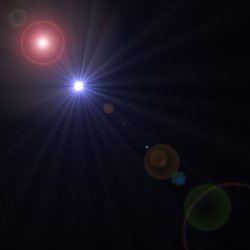-
Viewpoint on 'IONS'
Viewpoint on 'Scientific Literacy'
- Proudly sponsored by
-


-
Upconversion Reloaded

Recent results give new life to an old, almost forgotten technique: upconversion imaging could soon make possible the wide use of light technology for infrared detection.
-
A Seriously Defocused Spider

A jumping spider about to pounce on its prey needs to be able to accurately measure its distance from its target in order to be able to hit it with precision. This is possible thanks to a visual approach previously unknown to exist in nature.
-
Astronomical Twisters

Black holes are enigmatic astronomical objects, which remain, as of yet, unobserved. We may, however, be in a position to trace their trail. It is possible that a rotating black hole imparts small twists to photons passing nearby, which we may be able to detect from Earth.
Volume 8 Story 4 - 18/2/2010

If light were slowing down, we would have to revise many of our astronomical beliefs: from the age of the Universe to the distances between galaxies, from the dark matter to the definition of many physical constants. What a tremendous set of implications! Some evidence that this might indeed be the case starts piling up, as recently reported by Yves-Henri Sanejouand from the University of Nantes in France.
Of course, we must emphasize that the hypothesis that the speed of light, c, might be decreasing over time is still highly speculative. However, it has been recently shown that it might shed new light on some of the most challenging open scientific problems of today.
First of all, it was observed by Hubble at the beginning of the XX century that galaxies appear to be moving away from the Earth at a velocity that is proportional to their distance from us. The standard explanation is that galaxies are being thrown apart from the expansion of space-time. Imagine drawing some red spots on a balloon and inflating it, the spots (galaxies) would recede from each other at a speed proportional to their distance due to the dilatation of the plastic (space-time). The drawback of this hypothesis is that it needs to postulate the existence of the famous dark matter, which has never been observed and would still constitute 70% of the Universe’s mass. However, if c were decreasing over time, the Hubble effect would turn out to be a simple optical effect, eliminating the need to postulate the existence of the dark matter, as proposed by P. I. Wold back in 1935 [1].
Another one of the main open questions in modern cosmology is the so-called initial value problem: how should the Universe have begun for us nowadays to observe it as it is? In 1993, John Moffat from the University of Toronto in Canada proposed the idea of time-varying c to tackle this problem [2,3]: "I was curious," explains Moffat, "about whether there is an alternative to the standard inflation idea for solving the initial value problems in cosmology."
Another open puzzle in the astronomical community is the so-called Pioneer anomaly. The spaceships Pioneer 10 and Pioneer 11 were sent in the 1970s by NASA to explore the outer planets and then eventually they left the solar system. These are regarded as highly successful missions and have brought in plenty of data, which is still keeping astronomers busy today. However, both spaceships appear to be slightly and inexplicably accelerating towards the Sun, with an acceleration that increases with the distance. Again this can be explained once c is taken as being not constant over time, as Sanejouand recently proposed.
Even though the constancy of the speed of light is nowadays widely accepted, from a historical perspective it has not always been so. For a long time the very nature of light was only vaguely understood.
The ancient Greek philosophers were interested in light mainly as part of the vision process. It is noteworthy that the Greek word Optika referred to the science of vision and not the science of light, as it does now. The mainstream idea was that light was the vehicle carrying the objects’ colors to the eyes – and it did so instantaneously. In one version of such a theory the eyes themselves were emitting the light to touch the objects. In any case, the speed of light was tacitly assumed to be infinite.
It is not until the Renaissance that the first attempts to measure the speed of light took place. In 1676, the Danish mathematician and astronomer Ole Rømer gave the first reasonable estimate. He noted that the time elapsed between the eclipses of Jupiter with its moons became shorter as the Earth moved closer to Jupiter and became longer as the Earth and Jupiter drew farther apart. He could use this observation to estimate c.
The fact that light might have a finite speed, more than its exact value, encountered a fierce resistance in the scientific community, even though some happily endorsed it, notably Newton and Leibniz. It was only about fifty years later, and twenty years after Rømer’s death, that the British astronomer James Bradley’s measurements could definitively prove that the speed of light was indeed finite; it was 1727. More measurements were performed over the XIX century, including the ones by Fizeau (1849) and Foucault (1862). Finally, in 1879 Albert Michelson estimated a value of 299,940 km/s for the speed of light in vacuum, extremely close to the value accepted nowadays.
At that time, scientists commonly believed that light traveled in a special, not yet observed, medium: the ether. They assumed that light waves propagated through the ether just like sound waves propagate in the air. Since the Earth traveled through the ether, they also assumed that the speed of light must have differed in various directions. In 1887, Michelson and Morley set out to finally prove the existence of the still unobserved ether. To do so, their experiment wanted to prove that light travels at different speeds in different directions. However, their experiment failed: light was propagating exactly at the same speed in all directions and regardless of the motion of its source or observer!
Light had managed to shock the scientific community — again! After long discussions and experimental verifications, the fact that light is a universal constant was accepted. In 1905 Albert Einstein proposed the theory of relativity: the longstanding concepts of absolute time and space were definitively abandoned in order to preserve the constancy of the speed of light independently of the motion of source or observer.
It is clear now that the speed of light must be constant regardless of the propagation direction or the motion of the source or observer — indeed this is one of the postulates of Einstein’s relativity. The constancy of the speed of light is so fundamental and accepted now that in 1983 the 17th Conférence Générale des Poids et Mesures decreed that "The metre is the length of the path travelled by light in vacuum during a time interval of 1/299 792 458 of a second." At this point c cannot change by definition.
It is at this point of the story that the new question arises: What if the speed of light is not constant over time? What if it is slowing down? The very first consequence would be that our definition of meter would change over time: one meter would be slightly shorter, and we would accordingly become a bit taller. Of course, given the high-accuracy with which c has been measured any possible variation over time should be extremely small and it would probably have no consequences on our daily life.
The evidence reported by Sanejouand points towards a possible slowing down of c of about 0.02-0.03 m/s per year. This is extremely small compared with the actual value of c: it would be like having 1 billion dollars in a bank account and losing a few cents per year. However, "the constancy of the speed of light is one of the fundamental pillars of contemporary physics," explains Sanejouand, "so the possibility that it may instead vary (even at a slow rate) has far reaching consequences (although mostly on the theoretical side)." Even though the hypothesis of the slowing down of the speed of light is still a very speculative one, "people like Barrow, Magueijo, as well as John Moffat," Sanejouand concludes, "have opened the way by showing that physically consistent theories in which the speed of light is varying in time can indeed be developed in a safe and rigorous way."
[1] P. I. Wold, On the Redward Shift of Spectral Lines of Nebulae, Phys. Rev. 47, 217-219 (1935).
[2] J. W. Moffat, Superluminary Universe: A Possible Solution to the Initial Value Problem in Cosmology, Int. J. Mod. Phys. D 2, 351-365 (1993).
[3] J. W. Moffat, Quantum gravity, the origin of time and time's arrow, Found. Phys. 23, 411-437 (1993).

Is Light Slowing Down?
The speed of light is a universal constant — or is it? Some evidence seems to suggest it might actually be slowing down. Will we soon have to revise our cosmological beliefs?
Light. Is the speed of light changing over time? which evidence supports such hypotesis? and which could be the consequences?
Of course, we must emphasize that the hypothesis that the speed of light, c, might be decreasing over time is still highly speculative. However, it has been recently shown that it might shed new light on some of the most challenging open scientific problems of today.
First of all, it was observed by Hubble at the beginning of the XX century that galaxies appear to be moving away from the Earth at a velocity that is proportional to their distance from us. The standard explanation is that galaxies are being thrown apart from the expansion of space-time. Imagine drawing some red spots on a balloon and inflating it, the spots (galaxies) would recede from each other at a speed proportional to their distance due to the dilatation of the plastic (space-time). The drawback of this hypothesis is that it needs to postulate the existence of the famous dark matter, which has never been observed and would still constitute 70% of the Universe’s mass. However, if c were decreasing over time, the Hubble effect would turn out to be a simple optical effect, eliminating the need to postulate the existence of the dark matter, as proposed by P. I. Wold back in 1935 [1].
Another one of the main open questions in modern cosmology is the so-called initial value problem: how should the Universe have begun for us nowadays to observe it as it is? In 1993, John Moffat from the University of Toronto in Canada proposed the idea of time-varying c to tackle this problem [2,3]: "I was curious," explains Moffat, "about whether there is an alternative to the standard inflation idea for solving the initial value problems in cosmology."
Another open puzzle in the astronomical community is the so-called Pioneer anomaly. The spaceships Pioneer 10 and Pioneer 11 were sent in the 1970s by NASA to explore the outer planets and then eventually they left the solar system. These are regarded as highly successful missions and have brought in plenty of data, which is still keeping astronomers busy today. However, both spaceships appear to be slightly and inexplicably accelerating towards the Sun, with an acceleration that increases with the distance. Again this can be explained once c is taken as being not constant over time, as Sanejouand recently proposed.
Even though the constancy of the speed of light is nowadays widely accepted, from a historical perspective it has not always been so. For a long time the very nature of light was only vaguely understood.
The ancient Greek philosophers were interested in light mainly as part of the vision process. It is noteworthy that the Greek word Optika referred to the science of vision and not the science of light, as it does now. The mainstream idea was that light was the vehicle carrying the objects’ colors to the eyes – and it did so instantaneously. In one version of such a theory the eyes themselves were emitting the light to touch the objects. In any case, the speed of light was tacitly assumed to be infinite.
It is not until the Renaissance that the first attempts to measure the speed of light took place. In 1676, the Danish mathematician and astronomer Ole Rømer gave the first reasonable estimate. He noted that the time elapsed between the eclipses of Jupiter with its moons became shorter as the Earth moved closer to Jupiter and became longer as the Earth and Jupiter drew farther apart. He could use this observation to estimate c.
The fact that light might have a finite speed, more than its exact value, encountered a fierce resistance in the scientific community, even though some happily endorsed it, notably Newton and Leibniz. It was only about fifty years later, and twenty years after Rømer’s death, that the British astronomer James Bradley’s measurements could definitively prove that the speed of light was indeed finite; it was 1727. More measurements were performed over the XIX century, including the ones by Fizeau (1849) and Foucault (1862). Finally, in 1879 Albert Michelson estimated a value of 299,940 km/s for the speed of light in vacuum, extremely close to the value accepted nowadays.
At that time, scientists commonly believed that light traveled in a special, not yet observed, medium: the ether. They assumed that light waves propagated through the ether just like sound waves propagate in the air. Since the Earth traveled through the ether, they also assumed that the speed of light must have differed in various directions. In 1887, Michelson and Morley set out to finally prove the existence of the still unobserved ether. To do so, their experiment wanted to prove that light travels at different speeds in different directions. However, their experiment failed: light was propagating exactly at the same speed in all directions and regardless of the motion of its source or observer!
Light had managed to shock the scientific community — again! After long discussions and experimental verifications, the fact that light is a universal constant was accepted. In 1905 Albert Einstein proposed the theory of relativity: the longstanding concepts of absolute time and space were definitively abandoned in order to preserve the constancy of the speed of light independently of the motion of source or observer.
It is clear now that the speed of light must be constant regardless of the propagation direction or the motion of the source or observer — indeed this is one of the postulates of Einstein’s relativity. The constancy of the speed of light is so fundamental and accepted now that in 1983 the 17th Conférence Générale des Poids et Mesures decreed that "The metre is the length of the path travelled by light in vacuum during a time interval of 1/299 792 458 of a second." At this point c cannot change by definition.
It is at this point of the story that the new question arises: What if the speed of light is not constant over time? What if it is slowing down? The very first consequence would be that our definition of meter would change over time: one meter would be slightly shorter, and we would accordingly become a bit taller. Of course, given the high-accuracy with which c has been measured any possible variation over time should be extremely small and it would probably have no consequences on our daily life.
The evidence reported by Sanejouand points towards a possible slowing down of c of about 0.02-0.03 m/s per year. This is extremely small compared with the actual value of c: it would be like having 1 billion dollars in a bank account and losing a few cents per year. However, "the constancy of the speed of light is one of the fundamental pillars of contemporary physics," explains Sanejouand, "so the possibility that it may instead vary (even at a slow rate) has far reaching consequences (although mostly on the theoretical side)." Even though the hypothesis of the slowing down of the speed of light is still a very speculative one, "people like Barrow, Magueijo, as well as John Moffat," Sanejouand concludes, "have opened the way by showing that physically consistent theories in which the speed of light is varying in time can indeed be developed in a safe and rigorous way."
[1] P. I. Wold, On the Redward Shift of Spectral Lines of Nebulae, Phys. Rev. 47, 217-219 (1935).
[2] J. W. Moffat, Superluminary Universe: A Possible Solution to the Initial Value Problem in Cosmology, Int. J. Mod. Phys. D 2, 351-365 (1993).
[3] J. W. Moffat, Quantum gravity, the origin of time and time's arrow, Found. Phys. 23, 411-437 (1993).
Giovanni Volpe
2010 © Optics & Photonics Focus
GV is currently working as a postdoctoral researcher in optics, statistical physics and soft matter at the Max Planck Institute in Stuttgart (Germany).

Yves-Henri Sanejouand, About some possible empirical evidences in favor of a cosmological time variation of the speed of light, EPL (Europhysics Letters) (2009) 88, 59002 (link).